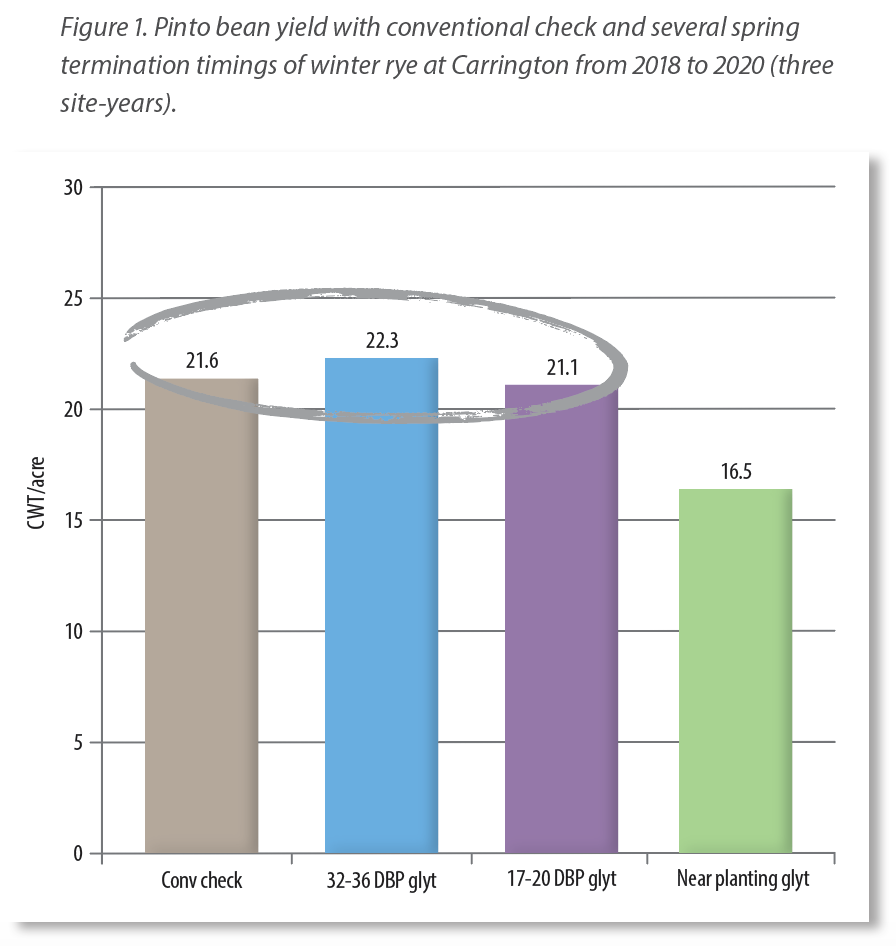Overview of North Dakota research
Greg Endres, NDSU Extension Cropping Systems Specialist, Carrington Research Extension Center, ND – Summer (June) 2021 Pulse Beat
FARMER INTEREST WITH cover crops in North Dakota is high and utilization is increasing. North Dakota State University has been conducting research to help support cover crop adaptation and use. Winter rye is a common cover crop that provides benefits including soil protection from erosion, soil moisture management and weed suppression. NDSU Extension has recently published the circular Growing Rye as a Cover Crop in North Dakota.
At the NDSU Carrington Research Extension Center (CREC), several multi-year studies are being conducted with winter rye as part of a production system with soybeans and dry beans. The following are overviews of two selected studies.
WINTER RYE PLANTING DATES AND RATES PRECEDING SOYBEANS
Winter rye has a wide fall planting period and range of rates, depending on goals for the cover crop. Rye is normally planted August through October at rates ranging from 30 to 60 lbs/ac. A study was commenced at the CREC in 2018 to examine impact of rye planting dates and rates on following year rye plant stand, ground cover, weed suppression and impact on soybean production.
Rye (ND Dylan) planting dates: 1) October 2, 2018 and September 26, 2019, and 2) October 31, 2018 and November 1, 2019. Averaged over two years (2019–20), rye plant densities (measured in May) with the first planting date and rates of 25, 50 and 75 lbs/ac were 236,200, 561,400 and 882,200 plants/ac, respectively. The late planting dates and three rates resulted in 101,000, 284,600 and 412, 700 plants/ac. Ground cover percentage with the first planting date ranged from 32 to 43% and late date ranged from 8 to 19%.
In 2020, foxtail and kochia suppression (visually evaluated late May prior to soybean planting) ranged from 0 to 10% with late rye planting during the fall of 2019, compared to 52 to 83% with the first planting date. Weed control generally improved with increasing rye planting rates. For example, kochia control was 83% with the early rye planting at 75 lbs/ac.
Rye was terminated with glyphosate one to seven days prior to soybean planting (late May). Averaged over two years (2019–20), soybean plant density (166,300 to 184,100 plants/ac) and seed yield (45.2 to 49.6 bu/ac) were similar among rye planting dates and rates.
In summary, rye planted earlier in the fall and at rates of 50 or 75 lbs/ac increased ground cover and weed suppression, while providing the environment for satisfactory soybean yield. The study continues in 2021, following rye planting dates of September 17 and October 8, 2020.
WINTER RYE PRECEDING PINTO BEANS
A study was started during the fall of 2016 at the CREC to examine impact of winter rye preceding pinto beans. Basic questions to be answered: 1) impact on bean plant growth and seed production, 2) termination timing of rye based on bean planting and 3) level of weed suppression.
During the four years of the study, winter rye was planted during the period of the last-half of September to early October at a rate of at least 60 lbs/ac. Pinto beans (Lariat or ND Palomino) were direct seeded in late-May to early June to establish a targeted stand of 70,000 plants/ac. Treatments were based on spring timing of rye termination, primarily with glyphosate: 1) conventional pinto bean production system check including use of preemergence (PRE) herbicide, 2) rye termination four to five weeks before pinto bean planting, 3) rye termination four to five weeks before pinto bean planting plus PRE herbicide, 4) rye termination two to three weeks before pinto bean planting, 5) rye termination near bean planting (green-planted bean) and 6) rye termination 10 to 14 days after bean planting.
Averaged over four years (2017–20), the greatest pinto bean seed yield among rye treatments was 24.0 cwt/ac compared to 22.5 cwt/ac with the conventional check. Dry bean yield averaged over three years (2018–20) ranged from 21.1 to 22.3 cwt/ac with preplant rye termination (about 2.5 to 5 weeks before bean planting) compared 16.5 cwt/ac with rye termination near bean planting (Figure 1). Reduced yield with delayed rye termination was primarily due to reduced topsoil moisture needed for bean seed germination and plant establishment. Excessive soil moisture was used by the rye and not replenished by timely rain.
Foxtail control (evaluated three to four weeks after bean planting) averaged 68% over three years with early preplant terminated rye (treatment 2, Figure 2). The delayed rye termination near bean planting (treatment 4) provided an average of 86% foxtail control compared to 78 to 80% control with treatments (1 and 3) of preplant glyphosate plus PRE herbicide.
In summary, properly managed winter rye as a cover crop preceding pinto bean can provide benefits, including soil protection from erosion, while dry bean yield potential can be maintained. Termination of rye must be carefully timed to maintain bean yield potential during plant establishment with dry conditions. Winter rye can compliment herbicides for weed management.


